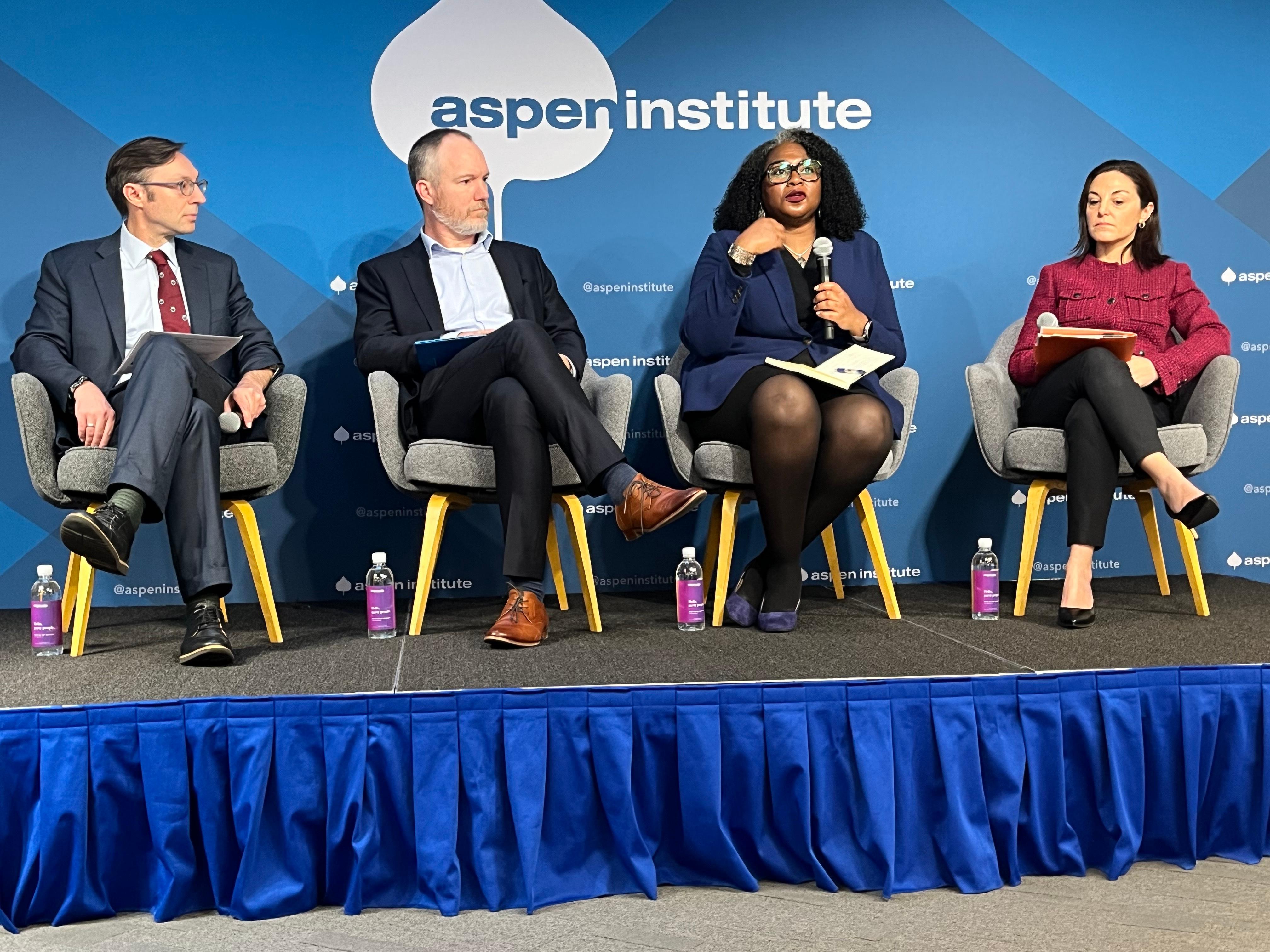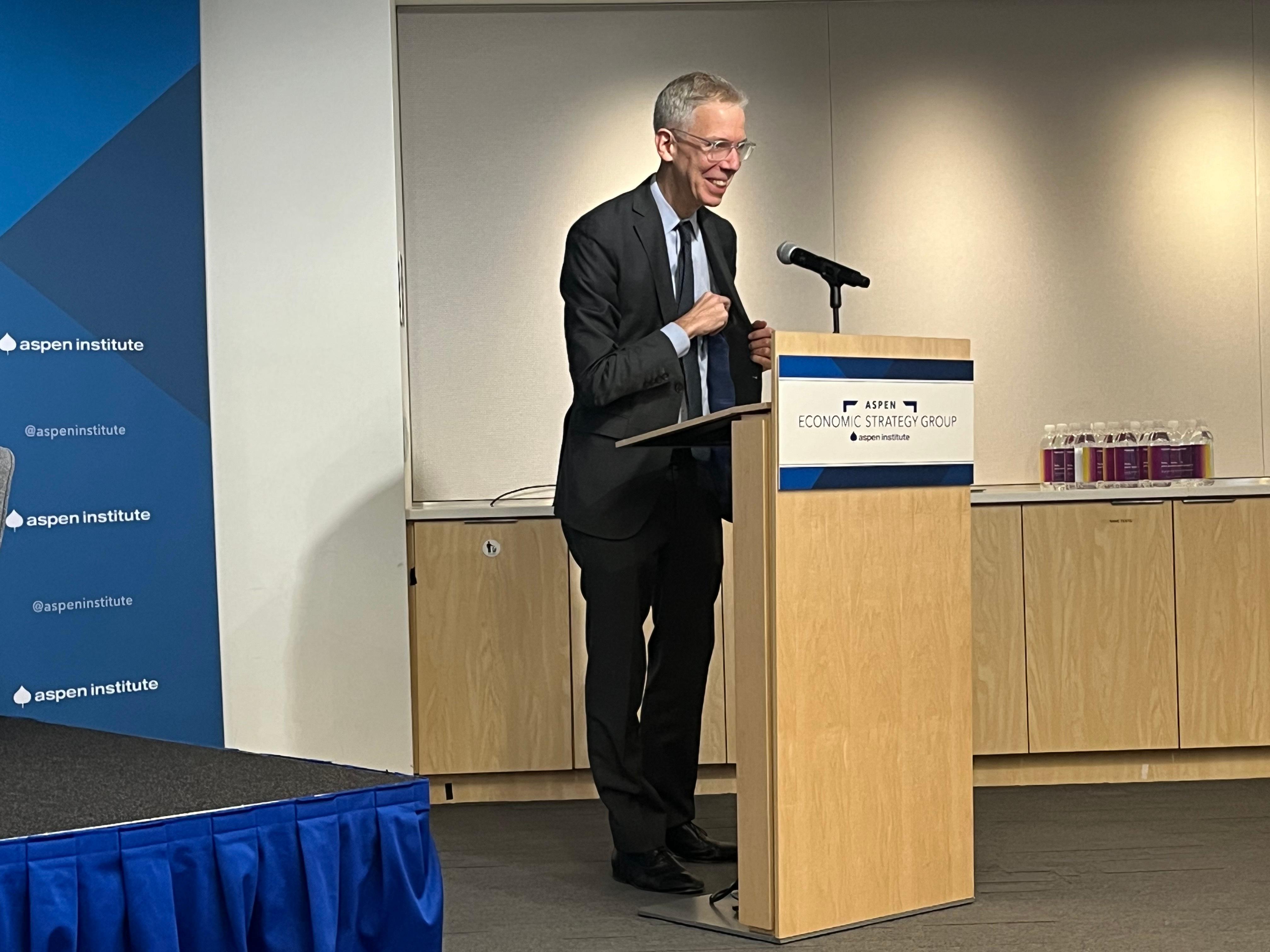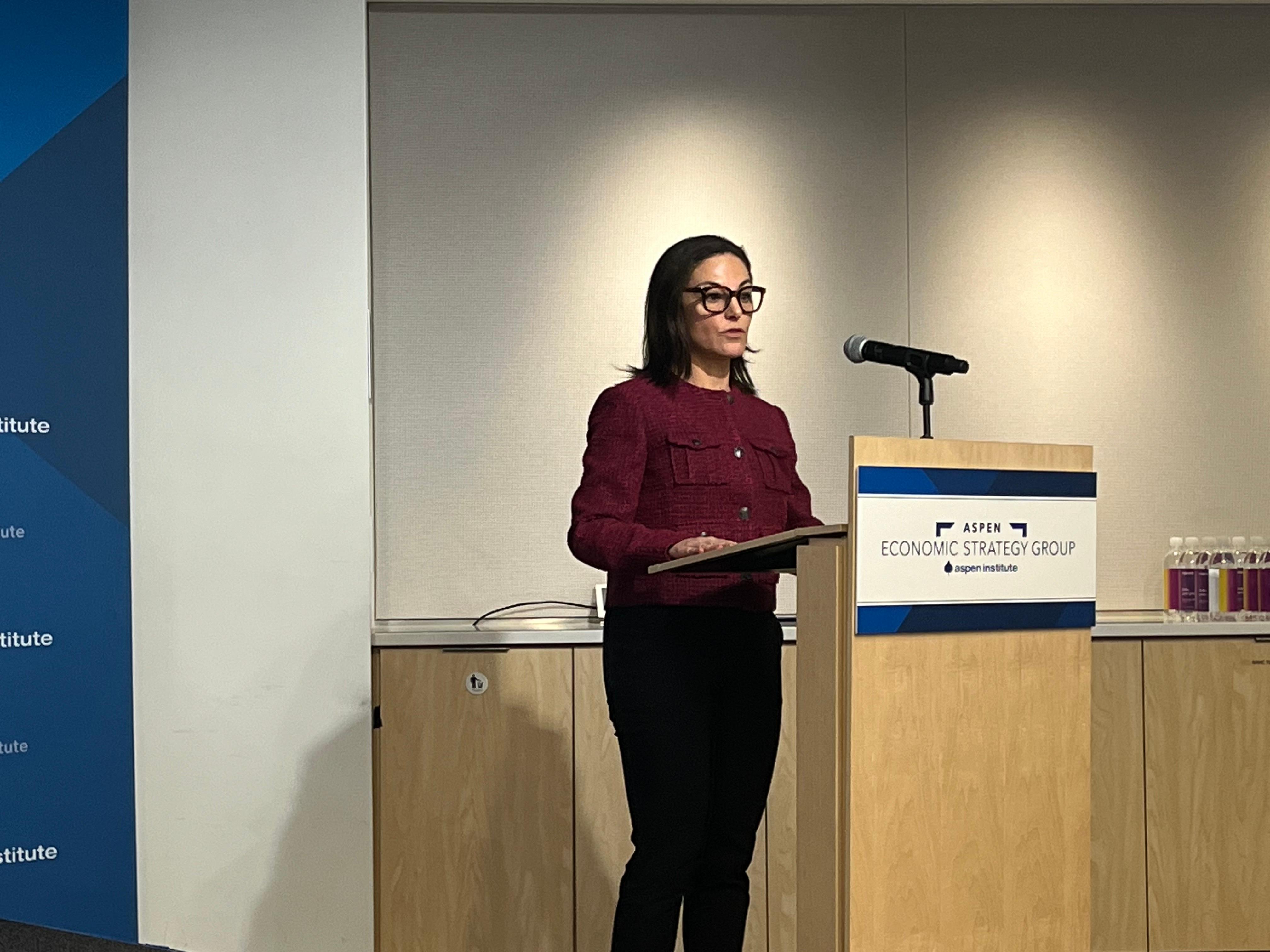Experts Argue that the Nation’s “Biggest Problem” is “Challenging, But Not Insurmountable”
A panel of economists and education leaders sounded the alarm on the pandemic’s potential lifelong impacts on schoolchildren at the Aspen Institute in Washington, DC, last week.

From left to right: Jens Ludwig, a University of Chicago professor; Nat Malkus, a senior fellow at the American Enterprise Institute; T. Nakia Towns, chief operating officer at Accelerate; and Melissa S. Kearney, a University of Maryland professor, discuss the pandemic’s potential long-term socioeconomic impact on student learning and the role of high-dosage tutoring in helping accelerate student learning at an event hosted last week by the University of Chicago and the Aspen Economic Strategy Group in Washington, DC.
Huge slowdowns in learning persist across the U.S. Students have fallen several grades behind. Absenteeism continues to rise to record levels.
There is still time to fix these issues.
The University of Chicago Education Lab’s Jens Ludwig, a panelist at the event and co-author of a paper titled “Overcoming Pandemic-Induced Learning Loss,” called the Covid learning interruption the “biggest problem facing America.”
Schools Need More Resources, Time, and Accountability for Recovery
Panelists issued a clarion call to policymakers to dedicate more resources and extend the time allowed to expend federal recovery funding to school districts to address learning needs. In addition, they called for greater accountability in ensuring that school districts use the money for evidence-based interventions “that are most effective in helping students learn.”
In a chapter in the Aspen Economic Strategy Group’s book Building a More Resilient Economy, University of Chicago Education Lab co-directors Jonathan Guryan and Jens Ludwig argue that greater investment in learning recovery efforts will be necessary to “avoid lifelong negative consequences for a generation of 50-million school-age children.”
Economists estimate that students who fall behind in school because of pandemic-induced learning interruptions face a “collective $900 billion loss in future earnings.”
Panel Discussion on Covid Learning Interruptions
Ludwig was joined by Nat Malkus, a senior fellow and deputy director of education policy at the American Enterprise Institute; Nakia Towns, chief operating officer at Accelerate Learning; and moderator Melissa Kearney, director of The Aspen Economic Strategy Group.
Robert Gordon, Deputy Director for Economic Mobility, White House Domestic Policy Council, offered the keynote remarks for the event. He laid out four key points:
- The Biden-Harris administration firmly agrees about the urgency to address the pandemic’s serious harm to student learning.
- The billions that the nation spent responding to the pandemic in schools, particularly in high poverty schools, have likely made an important difference.
- There's more we need to do to help schools help students to recover academically, and high-impact tutoring is an effective strategy.
- Looking forward, we are eager to sustain those investments in every way we can.

Robert Gordon, Deputy Assistant to the President for Economic Mobility at the White House, said during his keynote remarks at an Aspen Institute event last week that more teachers, tutors and technology are needed to help students recover from Covid-related learning interruptions.
Federal pandemic relief funding for public schools – known as the Elementary
and Secondary School Emergency Relief (ESSER) Fund – will expire in September 2024. The government is offering school districts opportunities to seek extensions to spend funds into 2025 to continue to help students.
Education Helps Economic Growth, Mobility and Equality
Kearney argued that, “We owe it to this generation of students to make up for the educational setbacks that they were saddled with. And it is in our nation's economic interest to do so.”
Ludwig contended that the federal funding provided to schools was probably not enough given the scale of the problem. While $190 billion is a big number, it represents funds spread over many years and only represents a 6 percent increase of what the U.S. already spends to educate public school children, he says.
“The federal assistance is basically running out,” he said. “It’s like we’re quitting at the finish line. Human capital is what drives economic growth. If you care about economic growth, you should really care about this.”
He added: “If the thing you care about instead is economic mobility and equality, you should really care about this. The kids most adversely affected by the pandemic … are the most economically and socially vulnerable kids in the country.”
High-impact Tutoring Helps Accelerate Learning
Panelists highlighted high-dosage tutoring as a key strategy for helping closing academic achievement gaps. While tutoring’s power to accelerate learning is well documented, only about 1 in 10 students receive high-dosage tutoring in their schools. Panelists acknowledged that implementing high-dosage tutoring during the school day, with well-trained tutors, several days a week can be difficult for school districts. Ludwig pointed to studies of Saga Education’s high-dosage tutoring approach in partnership with Chicago Public Schools as evidence of the power of tutoring to accelerate learning. In those studies, students gained as much as 2 ½ years of extra learning in one tutoring period embedded into their regular school day for one school year.

If Covid-related learning gaps go unaddressed, millions of American students will face lower lifetime earnings, said Melissa S. Kearney, director of the Aspen Economic Strategy Group.
“It’s challenging, but not insurmountable. The best evidence that we have around tutoring says that if you are able to do this for a school year, you can recover. The average four months of learning in K-12 that children are behind, you can recover in one year,” said Dr. T. Nakia Towns, Chief Operating Officer at Accelerate. Towns cited Baltimore City, Maryland and Guilford County, North Carolina as examples of school districts that have effectively implemented tutoring on a larger scale to help students.
“Baltimore City Public Schools were able to offer tutoring to 15,000 kids in the 2022-23 school year on an enrollment of about 70,000 students. This year, they expect to approach 20,000 kids,” she said. “Guilford County, North Carolina, similarly 12,000 students were tutored last year. There are districts penetrating 25-35% of kids that are able to receive tutoring. They are prioritizing the kids who were most vulnerable in terms of the pandemic.”
Ludwig also highlighted ways to reduce the cost of tutoring by incorporating technology. He cited another study with Saga Education and Chicago Public Schools where instead of working every school day with a tutor, students alternated days between working with a tutor one day and and the next day using a computer-assisted learning platform. Taking this approach reduced the cost of tutoring by one-third without affecting learning outcomes.
Student Absenteeism Rises
But getting students to school to take advantage of tutoring has become a second major challenge. Malkus said that student absenteeism doubled during the pandemic.
“The last time we had good data on that was 2022, when 29 percent of kids missed 10 percent of the year,” he said. “It’s gone down in 33 states but only by a few percentage points. That’s going to get in the way of pandemic recovery. Unfortunately, the kids who are most likely to be chronically absent are the kids who are in otherwise disadvantaged environments.”
Malkus said that “if we’re having kids not showing up for school at high rates, we’re looking at the same problem with high-dosage tutoring programs.”
High-Dosage Tutoring Can Help Address Absenteeism
Towns noted that one elementary school in Baton Rouge she visited had issues with students being chronically late to school, missing the first 20 to 40 minutes. The principal at the school offered tutoring at the beginning of school.
“When they rolled out the virtual tutoring program and communicated to parents that your child has an opportunity to engage with this literacy program and every day it will start promptly at 8:30,” Towns said, “[the principal] noted to me attendance has improved because parents thought, ‘Well, we [don’t want our kids] to miss something that is different.’”
Tutors, Teachers, Tech Needed
Gordon said that the US Department of Education has been encouraging colleges and universities to use Federal Work Study to pay some or all of the wages of college students for tutoring in K-12 while providing a “great clinical opportunity for future teachers in America.” Through the National Partnership for Student Success, school districts, nonprofits and higher education institutions are working to support more Americans serving as tutors.
“We need teachers and we need tutors, and if we can get technology to help them both succeed so much better for the students,” Gordon said. “We want to do everything in our power to close learning gaps. Tutoring is an enormously powerful tool for achieving that goal.”
Watch the full presentation.
